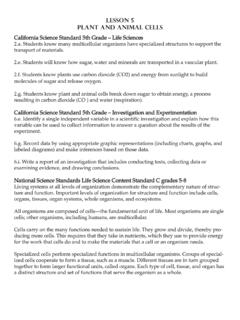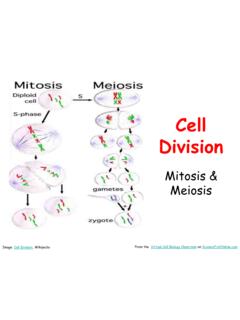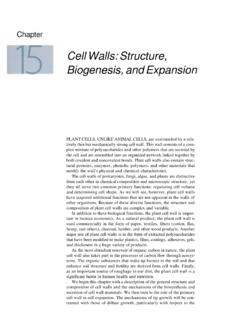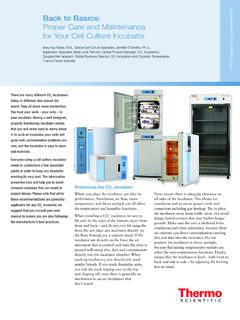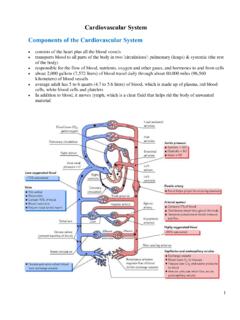Transcription of What are cells? What do cells look like? How many ...
1 Studying cells M arch 2020 Page 1 Studing CellsWhat are cells ? cells provide structure and function for all living things, from microorganisms to humans. Scientists consider them the smallest form of life. cells house the biological machinery that makes the proteins, chemicals, and signals responsible for everything that happens inside our bodies. What do cells look like? cells come in different shapes round, flat, long, star-like, cubed, and even shapeless. Most cells are colorless and see-through. The size of a cell also varies.
2 Some of the smallest are one-celled bacteria, which are too small to see with the naked eye, at 1-millionth of a meter (micrometer) across. Plants have some of t he largest cells , 10 100 micrometers across. The human cell with the biggest diameter is the egg. It is about the same diameter as a hair strand (80 micrometers). How many different types of human cells are there? The trillions of cells that make up a human are organized into about 200 major types. All of a person s cells contain the same set of genes (learn more on the Genetics Home Reference: What is a gene?)
3 However, each cell type switches on a different pattern of genes, and this determines which proteins the cell produces. The unique set of proteins in different cell types allows them to perform specialized tasks. For instance, red blood cells carry oxygen throughout the body. White blood cells kill germ invaders. Intestinal cells release molecules that help digest food. Nerve cells send chemical and electrical messages that produce thoughts and movement. And heart cells contract in unison to pump blood. What are eukaryotic and prokaryotic cells , and how are they different?
4 When putting cells into categories, scientists can tell eukaryotic cells apart from prokaryotic cells because they look different. Eukaryotic cells make up animals, plants, fungi, and some single-celled organisms. And they have a number of structures inside them, called organelles. The most prominent organelle is the nucleus, which contains the cell s genetic material, or DNA (learn more in the Biomedical Beat blog post Six Things to Know About DNA and DNA repair). Prokaryotic cells don t have a nucleus or other organelles.
5 They are single-celled micro-organisms that tend to be smaller than eukaryotic cells . There are two types of prokaryotic cells bacteria and archaea. Fibroblast cells with nuclei (blue, circular, center), energy factories (green, surrounding the nucleus), and the actin cytoskeleton (red, outermost). Credit: Dylan Burnette and Jennifer Lippincott-Schwartz, Eunice Kennedy Shriver National Institute of Child Health and Human Development, National Institutes of Health. Researchers used fluorescent tags to illuminate the intricate network of microtubule (yellow, center filaments) and actin filament (purple, outermost) fibers that build a cell's structure.
6 Credit: Torsten Wittmann, Scripps Research cells M arch 2020 Page 2 What are some of the major organelles in a human cell? In addition to the nucleus, the most prominent organelles include the following: Mitochondria, the cell s power plants, convert energy from food into the body s main energy source, adenosine triphosphate (ATP). Ribosomes are molecular factories that make proteins. The endoplasmic reticulum (ER), a network of interconnected sacs, processes newly made secreted and membrane proteins and produces fatty substances called lipids.
7 The Golgi complex receives proteins and lipids from the ER, packages them, and sends them to their final destinations inside the cell, within the cell membrane, or outside the cell. Lysosomes, the cell s garbage dumps, break down waste materials and dispose of them or recycle do cells move? Many types of cells can move. Single-celled organisms move to find food. And even cells inside multicellular organisms may need to get around. For example, immune system cells must move toward invaders. And sperm need to swim to fertilize eggs.
8 cells move in several ways. Some simply float through water or other liquids. Some push themselves along using long, thin proteins, called flagella, and cilia that stick outside the cell membrane and wave around. Some crawl along, using what s called amoeboid movements, in which cytoplasm-filled protrusions scoot the cell forward. Within cells , nutrients and organelles move around to carry out various cellular functions. This kind of internal movement is called cyclosis, or cytoplasmic streaming. The internal structure of cells , which is called the cytoplasm, creates a directional flow that pushes the contents of the cells around.
9 Scientists study cell movement to better understand how cells work, including how cancer cells move from one tissue to another and how white blood cells move to heal wounds and attack invaders. How do scientists study cells ? Cell biologists rely on an array of tools to peer into the body and examine cells . Imaging techniques magnify organelles and track cells as they divide, grow, interact, and carry out other vital tasks. Biochemical or genetic tests allow researchers to study how cells respond to environmental stressors, such as rising temperatures or toxins.
10 These tests can also label specific proteins using fluorescent tags and other chemicals that allow scientists to visualize proteins at work inside cells . Sophisticated computational tools then integrate and analyze all the data. How do our bodies make more cells ? One cell divides into two in a process called mitosis. Mitosis produces two genetically identical daughter cells from a single parent cell. Another type of cell division, meiosis, creates four daughter cells that are genetically distinct from one another and from the original parent cell.

